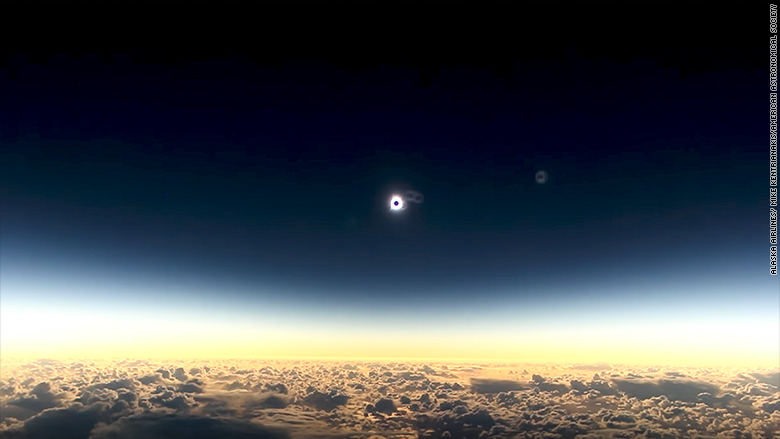
Some eclipse watchers want to be so sure they'll see the August 21st solar blackout that they're willing to leave the surface of the Earth to get a good view. A spot high in the air is the only guarantee your view won't be obstructed by clouds.
A special Alaska Airlines (ALK) flight will take off from Portland International Airport around 7:30 a.m. on Eclipse Day and will steer west, out over the Pacific Ocean.
With clouds far below the Boeing 737-900ER, astronomers, media and airline employees on the flight will be among the first to get a look at the total eclipse as it passes from west to east across the continental United States. It will be the first total solar eclipse visible in the contiguous United States since 1979.
The plane will spend about two hours out over the ocean to intercept totality. It's not only about getting to a specific spot in the sky, you have to do it at a precise time, too. Alaska's pilots have been practicing in one of the airline's simulators.
It's an incredibly complex four dimensional problem to solve, according to Glenn Schneider, an astronomer at the Steward Observatory at the University of Arizona who plotted the Alaska flight plan.
Related: How companies are cashing in on the solar eclipse
Schneider's calculations should have the aircraft in the 70 mile-wide lunar shadow at precisely 9 a.m. Pacific Time on Monday. That will give those on board a 1 minute and 43 second view of totality. That's slightly shorter than Carbondale, Illinois where the shadow will last a lazy 2 minutes and 38 seconds.
Why is that?
It's all about the view. The Alaska flight will fly at around 500 miles per hour perpendicular to the path of the shadow, to give the roughly 90 passengers the best look from the cabin.
The morning shadow off the Pacific coast will be moving at around 2,400 miles per hour as the sun comes up over the horizon. The shadow will slow to about 1,700 miles per hour around noon when the sun is high in the sky.
Even if you wanted to chase the eclipse across the sky, you'd be out of luck. "The only thing you could do this with is the Concorde, and that's not around anymore," said Schneider.
Scientists did just that back in 1973. The prototype supersonic Concorde, which could fly more than twice the speed of sound, chased the eclipse on a research flight as it crossed over Africa for 74 minutes.
"It's never been duplicated," said Schneider.
Schneider saw his first eclipse at age 14 and has been gobsmacked by them every since. "It's on such a tremendous celestial scale...you're the focal point."
This won't be Alaska's first eclipse-chasing adventure. In 2016, Alaska, with Schneider's guidance, adjusted the flight plan of an Anchorage to Honolulu flight to intercept totality over the Pacific. That eclipse crossed the South Pacific Ocean and never made landfall in the continental United States.
A Tough View
Other commercial carriers, like Southwest Airlines, are marketing flights that will fly along the path of totality. However, Schneider says catching the eclipse from those transcontinental flights is a big "maybe."
While the jets fly along the path of totality on routes like Denver to Atlanta, the eclipsed sun's shadow will cross from the west as they fly east.
"The pilots might have a nice view, but the passengers won't," says Schneider.
Schneider has developed software that takes into account all the different variables, like statistical winds at different altitudes and aircraft performance to find the perfect spot. And interception is easier for pilots in the age of modern aircraft and GPS.
However, nothing's perfect. Air traffic control or other airplanes may delay your takeoff, winds could speed up or slow down reaching the planned intercept within a 120 second window. Depending on what happens on the ground, the Alaska flight is ready with different contingency plans.
Crowded Skies
The skies on Monday will be filled with flights looking for the best view.
Private aircraft operator XOJET says that 38 aircraft have been chartered for the day of the eclipse to fly along the path of totality.
While many are eager to watch the eclipse from the sky, one airport in Oregon is keeping everyone on the ground for the main event.
The Madras Municipal Airport is expecting 400 airplanes to come and go over a four day period -- about five times more than normal, according to airport director Rob Berg. It's going to be so busy the airport is renting a portable control tower. Twenty-four thousand people are expected to watch there.
Related: New eclipse Forever stamp will magically transform into the Moon
But Berg said everything's going to stop come Monday morning. He doesn't want any distracted pilots.
Schneider will be watching from Madras, too.
He's had plans to be there for three years, and the statistical chance of cloud cover not obscuring the sun is ideal.
"It is the sweet spot on the path," he says.
